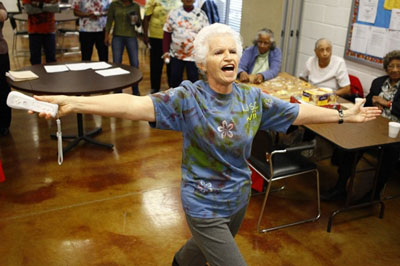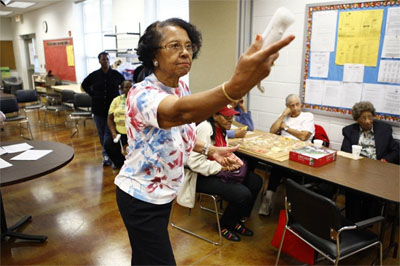November 23, 2009
By JOSHUA BROCKMAN
Say goodbye to shuffleboard and hello to Wii.
The introduction of the Nintendo Wii and its sports and fitness games has greatly expanded the appeal of video games — especially among senior citizens.
At 9:30 on a recent Monday morning at a rec room inside the Langston-Brown Senior Center in Arlington, Va., there is coffee and Danish pastry on one table. And on another table, there are four Wii controllers.
Mary Stewart-Malcolm, Sofia Henriquez, Violet Fenty and Willa Mae Graham reach for the controllers and turn toward the large-screen TV.
These four women are members of Langston-Brown’s Wii bowling team, and they’re dressed for the part: Each of them has on a handmade tie-dyed T-shirt emblazoned with the team’s name — LBSC Wii.

Sofia Henriquez, 76, celebrates after scoring in the Wii bowling competition. In addition to singing and dancing during the game, she cheered on her teammates with a noisemaker crafted from a soda bottle filled with pebbles. Coburn Dukehart/NPR.
They’re not the only seniors taking Wii bowling seriously: There are 186 teams and more than 1,000 bowlers in the throes of a virtual competition from California to New York as part of the National Senior League’s Wii bowling competition.
Eva Mayor, director of the Langston-Brown Senior Center, sets up the Wii and asks the bowlers if they’re ready.
“Ready!” they shout back.
And so are the spectators. On the sidelines, a crowd of seniors has gathered at tables to watch the competition while they play dominoes and assemble a large puzzle.
Wii Technology
Nintendo created the hardware and software that are behind Wii bowling with an eye toward expanding the traditional gaming demographic.
“I think what we were able to do was to make video games fun, accessible for a group of consumers who never had thought of themselves as video gamers before,” says Reggie Fils-Aime, president of Nintendo America.
For seniors, part of the appeal of Wii bowling is the nostalgia. It mimics the moves a bowler makes in an actual bowling alley, only players don’t have to reserve a lane, don bowling shoes or pick up a heavy ball. They just have to be able to wave their hand.
“You line up the ball, move a little to the left, a little to the right, line up the pins, and let it go. Try and get that hook going,” Fils-Aime says, describing the process.
It may be a virtual game played on a large flat-screen TV, but when Sofia Henriquez, 76, lunges forward and releases the invisible bowling ball with the hand-held controller, the emotions are 100 percent real.
After the pins scatter, her teammates erupt in applause. Henriquez does a victory dance to celebrate her strike and shouts “Langston-Brown, Langston-Brown” as she bangs on a table. The Wii also chimes in with its own encouragement after a player does well: A virtual commentator says “Nice throw!” or “Nice spare!”
Virtual sports have also spawned their own set of excuses. At one point, when a player doesn’t get the strike she wanted, she blames it on the batteries in the controller.
“Yeah, it’s the batteries,” Wanda Richardson, Langston-Brown’s program coordinator, says with a laugh. “I’m going to have to get some fresh ones.”
Going Head To Head Against Some Old Fogies
The team’s captain, 81-year-old Willa Mae Graham, used to be a 10-pin bowler back in the day.
How is it different bowling on the Wii?
“Much different, much different, because you don’t stand as close to the television, you know, as when you’re bowling with the ball,” Graham says.

Willa Mae Graham, 81, competes in a Wii bowling game at the Langston-Brown Senior Center in Arlington, Va. The interactive video game has gained popularity among seniors, bringing them together for socializing and low-impact exercise. Coburn Dukehart/NPR.
She bowls strike after strike, and her teammates cheer her on by shaking a plastic soda bottle filled with pebbles. Ultimately, Graham gets the highest score: 197.
Because their competition — a team in Seattle — wasn’t actually in the room, they didn’t know that the match was a real nail-biter. Days later, after entering their scores online, Langston-Brown learns that they won. But Mayor, the center’s senior director, knows there’s still some competition ahead.
One of the teams they’ll face is the Panther Valley Old Fogies from Nesquehoning, Pa. A reporter asks Mayor if she’s concerned. “Well, I really don’t know,” she says. “But I think we have a good team, we have a good group.”
Sure enough, Langston-Brown is a strong contender this season. And even though Wii bowling is scheduled three times a week, many players show up to practice every day.
© NPR
